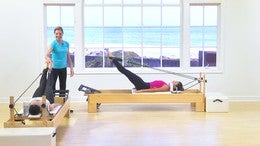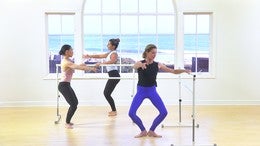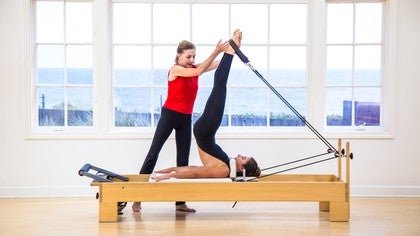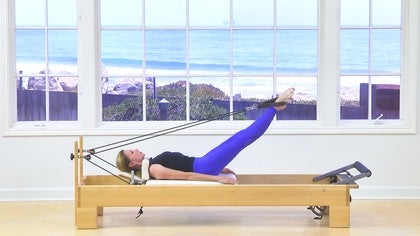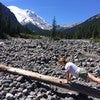Description
About This Video
Transcript
Read Full Transcript
Hello, I am Diane Diffenderfer and I am happy to be here for is anytime presenting a tutorial and I am going to talk about turnout today and turn out to be a little bit more specific. I'm going to talk about turnout of the legs. We can turn out other things, but in this time we're going to talk about external rotation of the leg at the hip joint, away from the midline into a in ballet terms first position or in the [inaudible] work, even to a Pilati stance, which is much less of external rotation. So that's what I'm going to talk about using a little bit of the reformer work. I have to say that when I first started [inaudible] many, many years ago, my studies, I was um, a little bit unsure about all the work in parallel and yet it came to be a very important part of my rehabilitation for my knee issues and alignment issues. So what I want to emphasize is that to understand turnout, we first have to check and make sure that our alignment is clean and correct in parallel. So having said that, I'd like to show first that I have, we know, I don't know that anybody's perfect. I sure am not.
I have really bowed legs. So that's what I was, uh, given, uh, by nature. And so in trying to correct my bow legged Ignis, I had to learn to pull my adductors together and actually fire up some of my external rotators to come into a more proper alignment in parallel. So rather than going into the bow that my legs naturally want to do, and then if I bend my knees, it's kind of a mess. I have learned to through the Palazzos work in parallel, work into a good alignment so that when I am straight or when I do bend my knees, my knees are in line with my feet coming from my hips. I want to take a moment and say that it's common knowledge that turnout comes from the hip. It should come from the hip. And yet some studies have suggested that there is also external rotation that happens in the knee and the shin bone and the foot.
But for our purposes as PyLadies practitioners, teachers, students, I'm going to talk about queuing from the hip and then the use of the gluteal muscles where we're applicable and also a really important part of it is where the pelvis is. So having said that, I'm going to show a little bit of work here on the reformer. So here I go and I would have normally started my program in parallel, but I'm going to go ahead and roll down and work in first position to get there. I'm going to extend my legs to perpendicular and turn out just slightly. I'm going to go back to parallel and I can see my knees. They're facing me and now they're facing away and they're facing me and they're facing away. I'm going to flex my feet.
I'm in Pilati stance and I'm going to come to a fairly,
So I'm going to keep it fairly narrow weight. On the second to third toe, my heels are touching, my knees are open into this small v and my thighs, knees, Shin Foot is all in good alignment. So having done that, I'm going to extend to my carriage and feel that small rotation and band. So this would be a more traditional type of working Pilati stance, leg and foot work or first position. So that's wonderful. We need our turnout in many of our exercises, semi-circle comes to mind right away. But for our leg and foot work, it's critical.
Now for dancers or others that might want to work on more external rotation, we can go wider. But when we do, it's not just the thighs. We definitely don't want to what I call drop and flop with no activation going on. We want to have a mindful awareness of how far we are allowed to turn out. So again, my turnout comes from my hips. Now I have the thigh, knee, Shin, ankle, foot in an equally distant external rotation. And then I can care fully do my full extension.
I like to inhale as I lengthen and exhale as I bend or plea AA. That's the way I was taught. Okay.
So whether we're in a wider turnout, a smaller turnout, parallel heals on the bar, lots of different things in leg and foot work. I'll go back to first position. I teach very as much as I can, very clearly that the pelvis is in a neutral position. So we know the navel to spine cue is excellent. We also want to think of the pubic bone to the sacrum and the sacrum on the carriage. So this whole pelvic area is flat.
I could balance a ruler here or a tray with tea cups and nothing would spill. So there's no twisting, shifting, arching, and most importantly no tucking. You try to do that a few times. You're in big trouble. You're going to get a really tired, low back and tightened hip flexors. So we want to have a length through the hip flexor.
So this is as straight an area as possible. So the term that I use, I'm sure many people do. Good teachers do neutral pelvis, neutral pelvis. Here's a tucked pelvis. Ouch. Here's an arched pelvis. Yeah, neutral pelvis. Now in addition to using our abdominals, particularly the transverse abdominals to connect that and keep it there, keep it stabilized. What are we about? What about our bar? Our buns, our dairy, air, our glutes? You need to engage these guys to help maintain the external rotation while keeping the neutral pelvis.
What happens if we say, oh, don't tighten your bud, or don't use your, but you could go back and forth and just have what I call a sloppy butt. And who wants a sloppy bud? If you think, oh, I got to squeeze my butt, then you're gonna probably start to grip and Tuck. So there's a couple of words that I like to use when I talk about what's happening with the dairy air, whether you call it the dairy or the bud or the buns. I like to say fire it up, engage it, turn it on, check into it. But I try not to use the words clench or grip or even squeeze because squeezing tends to create tension in the wrong way, but we definitely don't want to not use it. So that's my point about that. Um, and I think it's an important one. So, uh, back to first position, I kind of have a fun story here. After I had a knee operation I, which pull out, he's helped me, uh, rehab tremendously. I was working with Ron Fletcher, who was my mentor for many years and I was working very narrow and that's really all I wanted to do, maybe even less, maybe really narrow.
So I didn't want to put any undue stress on my knee joint. Then I rehabbed and everything was going along great. And one day Ron was standing there and he looked at me and he said, don't you have any more turnout than that? And I said, well, yeah, I do. And he said, well, go ahead, show me. So I went wider. Now mind you, I didn't, I didn't do the flop. And drop. I went wider and he said, go ahead, press out. And I did. And he said, well you can do that because you have that control and I'm not boasting here. I'm just sharing the story. And I said, well, I didn't know I was allowed to do that. And he said, well, if you do it correctly, turning out correctly, using your dairy or correctly keeping the pelvis neutral, he said, you sure can do that. And I said, but I've seen pictures of Joe doing it in a very narrow position. And he said, well that's because Joe didn't have a lot of turnout so you can take that story for what it's worth. But um, any way that I wanted to share that.
So here I'm back and forth again. But um, a couple other cues I wanna mention in first position about the feet. I already said the balls of the feet should be centered on the metatarsal, so we don't want to force the heels up. I see this a lot really screws the ankle around or sometimes people want to do a calf stretch and they put their heel down, which is a different exercise really. So what I talk about is you look up, the teacher is going to help you make sure your heels are right under your crotch. Yeah. And you have a space hold on the feet. That means they're not going up. They're not dropping down, they're not popping open, they're not sickeling. They're held in space.
And then with that little pressure on the heel and the line, I think are the core going this way to not just here, from the heel, through the tailbone, through the spine, and now through the crown. I'm going to zip up into one beautiful long line and her thighs facing the ceiling, knees in line with the feet neutral, pelvis long back, not arched, not tucked, neutral pelvis. I said that a few times already engaging the backs of the thighs without tucking and I feel pretty good. You could apply the same thing to your second position if you want to do that. I like to do the heels right in the corners of the foot bar.
Affirm flection of the feet. Watch that. You don't do this, especially dancers. That's not turnout that screw screwing your ankle around. So have your alignment correct. Again, Phi knee, Shin Foot, and the same thing, neutral, long through the hip flexor. Not Tucking, not arching, not sloppy, engaged, but not tucking. [inaudible] I love this stuff.
Going along the same lines of what I just talked about. Again, I have a long back on neutral pelvis, navel to spine, pubic bone to Sacrum, holding my legs at a nice 45 degree angle. I'm going to simply rotate from the hip and back to parallel. Rotate from the hip and back to parallel.
But to talk about the turnout, we rotate again from the top. We use the buttocks without clenching and gripping. We keep that pelvic area stable and then we come up not, doesn't have to be too high and find first and up equidistant legs first. I'm sure y'all know this one. Teach it well. Do it well. It's a beautiful exercise on the reverse.
We release the hamstring, engage it, stretch it a bit in gauge yet. Make sure you get to first position at the top. Yeah, I like to talk about finishing your sentence. So here's the sentence. There's the period or the exclamation point, whatever tempo you choose to do. Yeah. One more thing here. Combining parallel and external rotation.
You might try coming up in parallel turnout, circle in turnout, rotate back to parallel, and then get a flow of movement here. So you have quite a bit going on. Yeah, you have to think about the leg rotating in and out in the hip socket. While it's moving in a circular pattern, you can reverse it. [inaudible]
I feel my external rotators. I don't feel my knees. I don't feel my ankles. I feel pretty good. Thank you. [inaudible].
Exercise Breakdowns & Tips: Tutorials with Diane Diefenderfer
Comments
You need to be a subscriber to post a comment.
Please Log In or Create an Account to start your free trial.
